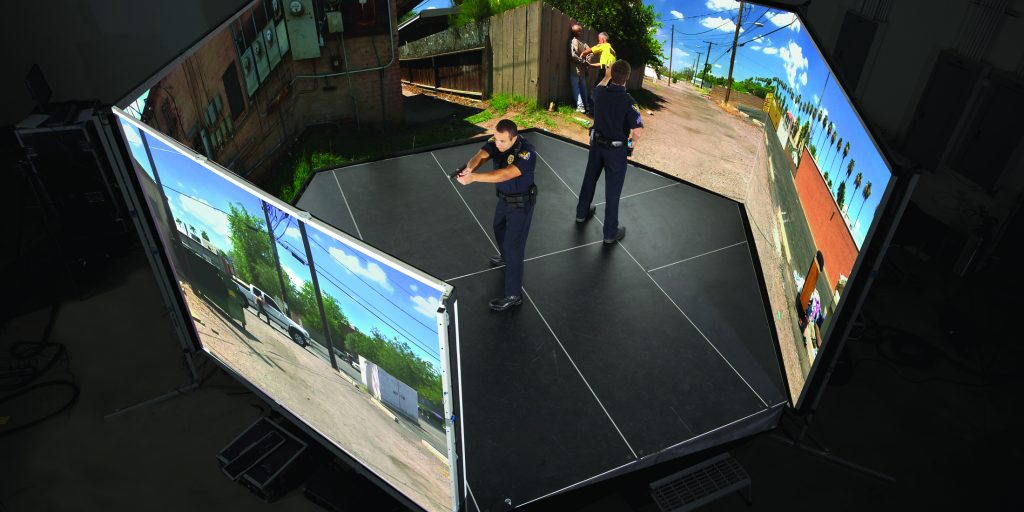How virtual reality simulators are changing law enforcement training
There’s a pressing need for improvements in effective police training. Officers need to hone their skills for managing crisis situations and de-escalating dangerous encounters. Repeatable and accurate training is required to build their resiliency to stress and encourage them to make the right decision based on proven methodologies.
But training doesn’t equal improvement – effective training equals improvement. By using virtual reality (VR) that places officers in consequential situations, departments are seeing significant improvements in de-escalation, decision making and better handling situations to keep both the public and the officers safe from harm. It’s an exciting time when agencies throughout the country are starting to embrace the right technology approach for an industry and culture that’s historically been resistant to change.
The VR opportunity
Police instructors now understand there are severe limitations to the value of lecture-based training when split-second decisions are involved. Making these fast judgements is a massive demand on the trainee’s physical and mental abilities. “Realistic practice makes progress” like so many things, including police skills. They can develop skills to produce positive outcomes, if given the chance. Lectures have their place in teaching policy and aiding community interactions, but intense real-world situations require uncompromisingly realistic (think ‘effective’) simulations to produce empathic and compassionate responses.
Modern virtual reality programs with certified training content are ideally suited for police training for multiple reasons. The industry leader’s technology itself is robust, with actual actors, and with the ability to customize scenarios on the fly, an encounter with a threat can branch off into many directions, emulating a real-life situation.
Once a solution is in place, department trainers can conduct many sessions per officer, giving them the chance to reinforce positive behaviors through repetition. They can review video sessions to highlight the officer’s use of verbal skills and provide guidance for escalated actions. It enables officers to learn about judgmental use-of-force and how different variables warrant different reactions and result in varied outcomes. It provides a low-risk, yet intense and realistic stage for police training and improvement.
Finding the right technology partner
Using VR-based training is only effective when it’s supplied by a firm that can provide advanced technology and the right proven methodologies. Departments should choose a program that uses full-size floor-to-ceiling video screens as well as simulation weapons that are very similar to firing the actual weapon with each shot being accurately tracked by the simulator.
In addition, it’s helpful to choose a system that has a physical component such as receiving a painful pinch through an electric impulse. This would simulate return fire, explosions, and other possible sources of harm. This physical component is meant to elicit a stress response in the trainee, who then needs to ignore the painful feedback while focusing on making fast yet appropriate counter actions. It’s a more immersive and effective training tool when compared to flashing lights or firing nylon projectiles at the trainees which has been mainly discontinued.
Advanced VR platforms work only when they accurately simulate the physical and mental aspect of real-life. By immersing officers into different scenarios where there might only be “OK” but no “good outcomes,” their cognitive and judgmental skills are put to the test. The training should be backed by a science and evidence-based approach, where officers are not just relying on muscle memory or force. The encounters should be accurate to the degree that an officer’s training “gun” accuracy is tracked by the system, so if lethal force is required, the training will show the results.
Encountering and learning from difficult situations
The best VR training platforms give officers a safe place to make mistakes. The tool should present multiple certified scenarios and options to test officers’ responses and allow them to learn and grow from errors, instead of learning them out in the field.
Advanced platforms should offer scenarios with actors of various ethnic backgrounds and genders. The actors can all present the same behaviors and timing within the simulated encounter, so law enforcement agencies can spot and train for any discrepancies in officers’ responses. It’s an important part of the training to uncover any biases, so supervising officers can interject with additional training and guidance.
This new style of training is much more involved than traditional “shoot-don’t-shoot” scenarios, because the simulation design is based on special curriculum from the world’s expert on de-escalation and human factors. Departments can go one step further and find a VR platform with a comprehensive training academy curriculum that goes beyond de-escalation and covers mental health issues, autism, K-9 encounters, medical emergency situations, and other scenarios that require a calm head that can react quickly.
When you choose a platform, consider one that constantly updates the training, making it more realistic, immersive and effective for the officers. Police training is trying hard to meet the inescapable need of preparing officers so well that they make excellent decisions in every law enforcement situation. With the help of a VR training platform, departments are noting improvements in training outcomes and have realized the longer-term benefits protecting and serving the streets.
Bob Ferris founded Ferris Production in 1993 – which later became VirTra – before becoming the CEO and Chairman in 2008. Throughout his career, Bob has been pushing the state-of-the-art envelop to achieve the most effective training simulators possible to benefit millions of people throughout 33 countries.





















Composer